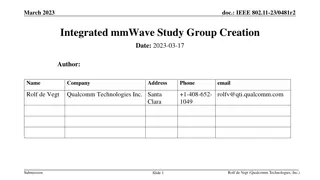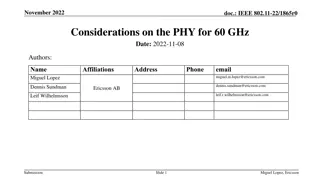Insights on IEEE 802.11-24/1102r1 for Industrial mmWave Applications
Proposed concerns and suggestions regarding millimeter wave applications in industrial scenarios based on IMMW SG PAR document and specific requirements. Detailed insights shared on mmWave application development for industrial settings including AGV, AMR, throughput, latency, reliability, and spatial stream considerations.
Download Presentation

Please find below an Image/Link to download the presentation.
The content on the website is provided AS IS for your information and personal use only. It may not be sold, licensed, or shared on other websites without obtaining consent from the author.If you encounter any issues during the download, it is possible that the publisher has removed the file from their server.
You are allowed to download the files provided on this website for personal or commercial use, subject to the condition that they are used lawfully. All files are the property of their respective owners.
The content on the website is provided AS IS for your information and personal use only. It may not be sold, licensed, or shared on other websites without obtaining consent from the author.
E N D
Presentation Transcript
July 2024 doc.: IEEE 802.11-24/1102r1 Thoughts on IMMW For the Industry Use Date: 2024-07-01 Authors: Name Affiliations Address Phone Email Yue Xu xuyue57@Huawei.com Chenhe Ji Huawei Nanjing R&D Institute, Nanjing, Jiangsu, China, 210012 Mengshi Hu Huawei Chun Pan Xiaofei Bai Submission Slide 1 Yue Xu (Huawei)
July 2024 doc.: IEEE 802.11-24/1102r1 Introduction Based on the IMMW SG PAR document[1] and actual requirements in industrial scenarios, we propose the following concerns and corresponding suggestions. Submission Slide 2 Yue Xu (Huawei)
July 2024 doc.: IEEE 802.11-24/1102r1 Recap: IMMW SG PAR[1] PAR Real [2] Type Brief info Use Case Range Throughput Delay (ms) Reliability AGV / AMR Including guidance control, process data exchange, video/image, and emergency stop, between robots and a control system, 4k UHD Transmission < 5 m < 10 Gbps 10~20 jitter<5ms jitter <5 ms, PER<10E-2 VR < 10 m 10~20 Gbps 5~10 Robot/drone motion control Remote operation with haptics communication, programmed robot operation with emergency stop. IoT Sensors/ WIFI sensing High-density deployment and Periodical/event-based report of information to the control system. We believe that the content mentioned in the PAR document aligns with the development of application requirements for millimeter waves in industrial scenarios. However, these discussions are at a high level. Therefore, we aim to further share some of our detailed insights and perspectives on mmWave applications in industrial settings. AGV: Automated Ground Vehicle AMR: Autonomous Mobile Robot Submission Slide 3 Yue Xu (Huawei)
July 2024 doc.: IEEE 802.11-24/1102r1 Sharing - 1 The fast deployment From the PAR, the core idea is the fastdeployment . And we think: Reuse/Minimum-adjust current baseband architecture Reuse/Combine current-technique (e.g., Sounding, MLO, Power saving, TWT ) Design Appropriate Bandwidth/KPIs The design should be reasonable to facilitate quick deployment. different from the existing standards to show the advanced nature. Bandwidth Concern#1 Throughout/Latency/Reliability Concern#1 Yue Xu (Huawei) Submission Slide 4
July 2024 doc.: IEEE 802.11-24/1102r1 Sharing - 2 The Spatial Stream STAs AP In the MIMO, data is divided into multiple independent spatial flows. More spatial flows indicate more paths for independently processing data and a higher rate. Setting: 11ax, 160MHz, 45G Band, 16QAM Multiple streams can: - ensure the throughput to help meet traditional and emerging requirements even in the densest environments - enhance the stability (link optimization). However, the increase in the number of flows inevitably increases the cost of hardware devices (hindering fast deployment). Meanwhile, the gain accelerate is slowing down . The performance of a single flow may not meet the requirements. #SS throughput 1 350 Mbps 2 650 Mbps 4 1.2 Gbps Spatial Stream Concern#1 Throughout/Latency/Reliability Concern#2 The gain efficiency is decreasing. Yue Xu (Huawei) Submission Slide 5
July 2024 doc.: IEEE 802.11-24/1102r1 Sharing - 3 The Sensing/Ranging Sensing and Ranging has been widely discussed (more than 20 uses case in [3]). And, commercial products have already application them without any standardization Bandwidth 80MHz 160MHz 320MHz 640MHz 1280MHz Distance Resolution (m) 1.875 0.9375 0.4688 0.2344 0.1172 Object Existence Detection Object Counting Motion recognition 802.11bf and 802.11az/bk are main IEEE standard for Sensing and Ranging. So, IMMW can be considered to provide support for these technical standards.. More information More cost Less information Lower cost Larger bandwidth Higher resolution Lower bandwidth Less resolution [4] balance Bandwidth Concern#2 Submission Slide 6 Yue Xu (Huawei)
July 2024 doc.: IEEE 802.11-24/1102r1 Summary From the above 3 sharing opinions and corresponding concerns. We would like to provide our suggestions that: Main Concern Suggestion Bandwidth We recommend a minimum bandwidth of 160 MHz and a maximum bandwidth that is appropriate for fast deployment and standard differentiation. This approach will meet actual throughput requirements (e.g., 10 Gbps@client side) and expand the ecosystem. We recommend limiting the number of spatial streams to avoid excessive complexity. Specifically, using no more than 2SS under SU-MIMO is preferable. Spatial Stream Submission Slide 7 Yue Xu (Huawei)
May 2024 doc.: IEEE 802.11-24/1102r1 SP1 Do you agree that Move to add the sentence It is capable of supporting no more than 2 Spatial Streams. to the end of the 2nd paragraph of clause 5.2.b of the PAR.? -Yes -No -Abstain Submission Slide 8 Yue Xu (Huawei)
July 2024 doc.: IEEE 802.11-24/1102r1 References [1] 11-24-0116-03-immw-immw-draft-proposed-par [2] 11-23-1570-00-0uhr-latency-consideration-of-industrial-scenarios [3] 11-24-0723-01-immw-sensing-and-ranging-in-immw [4] 11-20-1712-02-00bf-wifi-sensing-use-cases Submission Slide 9 Yue Xu (Huawei)























